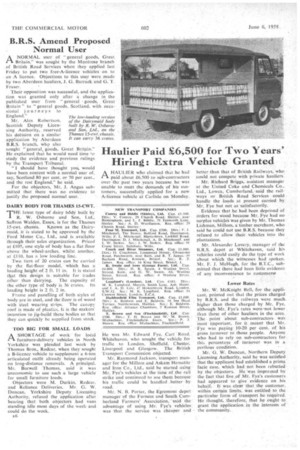B.R.S. Amend_ Proposed Normal User
Page 50

If you've noticed an error in this article please click here to report it so we can fix it.
.1-1 A NORMAL user of "general goods, Great.
Britain," was sought by the Montrose branch of British Road Services when they applied last Friday to put two free-A-licence vehicles on to an. A licence. Objections to this user were .made by two Aberdeen hauliers, J. G. Barrack and G. T. Fraser.
Their opposition was successful, and the application waS granted only after a change in the 'published user from "general goods, Great Britain" to "general goods, Scotland, with occasional journeys to England."
Mr, Alex Robertson, Scottish Deputy Licensing Authority, reserved his decision on a similar application by Aberdeen B.R.S. branch, who also sought "general, goods, Great Britain," He explained that he would need time to study the eviderice and previous rulings by the Transport Tribunal.
"I should have thought you. would have been content with a normal user of. say, Scotland .80 per cent. or 70 per cent.. and the rest England," he said.
For the objectors. Mr. 3. Angus subs mitted that there was no evidence to justify the proposed normal user.
The Low-loading version of the Dairymaid body built by R. W. Osborne and Son, Ltd., an the Thames 15-cwt. chassis. It can carry 36 crates.
DAIRY BODY FOR THAMES IS-CWT.
'FHE latest type of dairy body built by R. W. Osborne and Son, Ltd., SaffrOn Walden, Essex, is for the Thames• 15-cwt. chassis. Known as the Dairymaid, it is stated to be approved by the .Ford Motor. Co., Ltd., and is available through their sales otganization. Priced at £105, one style of body has a flat floor above the wheel-arches, whilst another, at £110, has a low loading line.
Two tiers of 20 crates can be carried by the flat-floor model, which, has a loading height of 2 ft. II in. It is stated that this design, is suitable for trades other than dairying. The' capacity of the other type of body is 36 crates. Its loading height is 2 ft. 2 in.
Frame and panelling of both styles of body are in steel, and the floor is of wood with -Steel wearing strips. The canopy roof is made of plastics. It is the makers' intention to jig-build these bodies so that they can quickly be supplied from stock.
TOO BIG FOR SMALL LOADS
riAA SHORTAGE of work for lodal furniture-delivery vehicles in North Yorkshire was pleaded last week by Thomas Bros., Redcar, when they sought a'B-licence vehicle to supplement a 6-ton articulated outfit already being operated on long-distance removals. A principal. Mr. Burwell Thomas, said it was Uneconomic to use such a large vehicle for small furnitureloads.
Objectors were M. Durkin, Redcar. and Reliance Deliveries. Mr. G. W. Duncan, Yorkshire Deputy Licensing Authority, refused the application after hearing that both objectors had vans standing idle most days of the week and could do the work.
E6 He was Mr. Edward Fye, Cart Road. Whitehaven, who sought the vehicle for traffic to London, Sheffield, Chester, Liverpool and Glasgow. The British Transport Commission objected.
Mr. Raymond Jackson, transport manager for the Millom and Askam Hematite and Iron Co., Ltd., said he started using Mr. 'Eye's vehicles at the time of the rail strike and continued to use them because his traffic could be handled better by road.
Mr. N. B. Porter, the Egremont depot manager of the Furness and South Cumberland Farmers' Association. said the advantage of using Mr. Eye's vehicles was that the service was cheaper and








































































































































